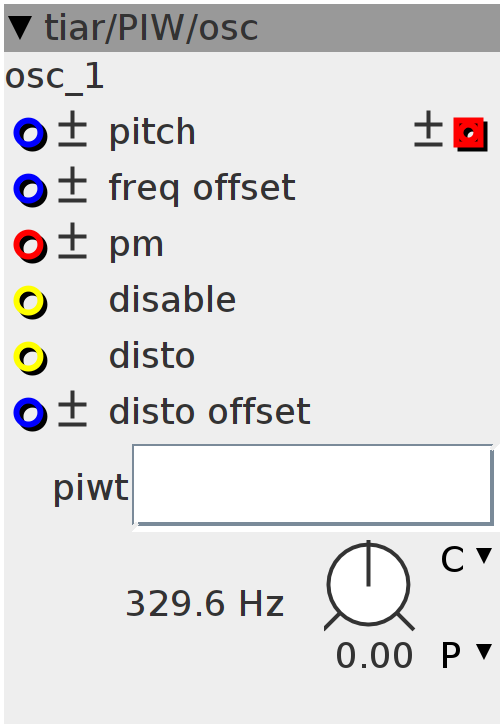osc
PIWT osc, needs to connect to a PIWT. Experimental.
Inlets
frac32.bipolar pitch
frac32.bipolar freq offset
frac32.bipolar disto offset
frac32buffer.bipolar pm
bool32 disables the object
bool32 use the waveform as a distortion
Outlets
frac32buffer.bipolar wave
Parameters
frac32.s.map.pitch pitch
Attributes
objref piwt
uint32_t p; // phase
int32_t dp; // delta phase aka freq
int32_t x0, x1, I1_0, I1_1;
int32_t kMI; // Modulation Index
int32_t aMI, dMI; // interp Modulation Index
// _____________________________________________________________________// _____________________________________________________________________
p = 0;
dp = 1;
x0 = 0;
x1 = 1;
I1_0 = I1_1 = 0;
aMI = dMI = kMI = 0;
// _____________________________________________________________________if (!inlet_disable) {
// _____________________________________________________________________
MTOFEXTENDED(param_pitch + inlet_pitch, dp);
dp += ___SMMUL(0x01000000, inlet_freq_space_offset);
dp >>= 32 - 20 - attr_piwt.LENGTHPOW;
// (need to calculate x0 - x1 even with over modulation)
// _____________________________________________________________________
// Audio rate loops
const int rightShiftPM = 9 - attr_piwt.LENGTHPOW;
const int shiftDisto = attr_piwt.LENGTHPOW - 4;
for (int j = 0; j < BUFSIZE; j++) {
if (inlet_disto) {
p = (inlet_disto_space_offset >> 4) << shiftDisto;
} else {
p += dp; // phase increment
if (p >= 0x40000000) {
p -= attr_piwt.LENGTH << 20; // length of one cycle
x0 -= attr_piwt.LENGTH << 20; // p, xO and x1 must be consistent
}
}
x1 = x0;
I1_1 = I1_0;
x0 = p + ((inlet_pm[j] << 3) >> rightShiftPM);
// differentiation part 1/3
// we launch the float div here (14 cycles !!)
// so that integer ops execute in parallel :D
float inv = ((float)(1 << 27)) / ((float)(x0 - x1));
// Now we do as many int ops as we can to fill ~14 cycles
// the interpolation coefficient
int32_t a = (x0 & 0x000FFFFF) << 11; // 0 -> 1 q31
// the segment number
uint32_t i =
(x0 & (attr_piwt.LENGTHMASK << 20)) >> 20; // [0 attr_piwt.LENGTH-1]
// polynomial calc of the integrand on segment i at position a
// the polynomial is
// I1_0 = Iv + a * v + (a^2/2) dv
// it is the integrand of v + a*dv
// a^2/2 q31
int32_t a2_2 = ___SMMUL(a, a);
I1_0 = ___SMMUL(attr_piwt.v[i], a);
I1_0 = ___SMMLA(attr_piwt.v[i + 1] - attr_piwt.v[i], a2_2, I1_0);
I1_0 = attr_piwt.Iv[i] + (I1_0 << 1);
int32_t v =
___SMMLA(a, attr_piwt.v[i + 1] - attr_piwt.v[i], attr_piwt.v[i] >> 1)
<< (attr_piwt.GAIN + 1);
// we differentiate the integrand in the interval
// x0 x1: ie in the interval between now and the preceding
// input.
// differentiation part 2/3
int32_t diff = I1_0 - I1_1;
// now, the result of our float division should be available.
// we haven't wasted our time waiting for it.
// differentiation part 3/3
if (abs(x0 - x1) > 256) // we avoid ill cases
outlet_wave[j] = (int32_t)(diff * inv);
else {
outlet_wave[j] = v;
}
}
} else { // disabled
if (inlet_disto) {
for (int j = 0; j < BUFSIZE; j++) {
outlet_wave[j] = inlet_pm[j];
}
} else {
for (int j = 0; j < BUFSIZE; j++) {
outlet_wave[j] = 0;
}
}
}